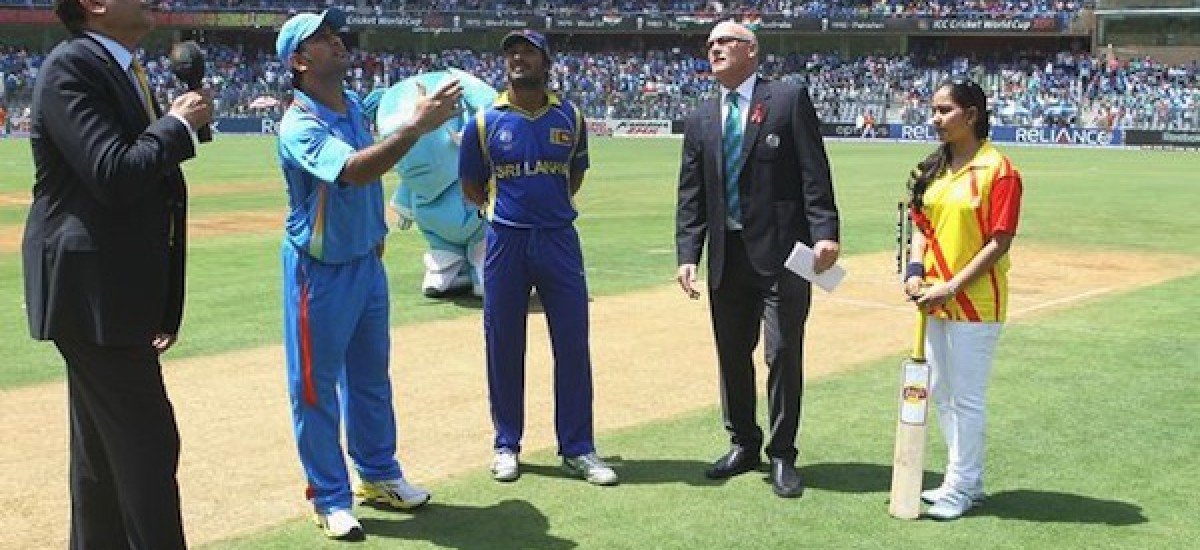Image courtesy Business Live
There was a truly remarkable moment at the start of the World Cup Final between India and Sri Lanka. Amidst a deafening cacophony of noise Match Referee Jeff Crowe, TV Compere Ravi Shastri and the two captains assembled at the centre of the ground to make the toss, or kaasi vaasi (the advantage or leanings of the toss) as they call it so appropriately in Sinhala.
Dhoni tossed the coin and Sangakkara called “Heads” (in a rather indistinct fashion it is said). But as the Referee picked up the coin it transpired that neither he, Shastri or Dhoni had heard the call because of the background cacophony. Worse still, it appears that Dhoni misheard the call as “tails” and Michael Vaughan in the commentary position heard it the same way and therefore contends that Sangakkara indulged in some skullduggery by allowing Dhoni to spin the coin again.
So, the procedure was repeated. Sangakkara called – or maybe shouted – “Heads.” Heads it was. So battle commenced and we know the outcome.
Vaughan’s accusation is a serious matter. Let me place it on hold in the too-difficult-basket till Shastri, Crowe, Sangakkara and others, including audio specialists, resolve the issue. Assume for the moment that Sangakkara had called “heads” initially. Then, I ask, what if the coin ended up “Tails” and Dhoni took the decision to field or bat? Would Sangakkara and Sri Lanka then have been aggrieved and raised a complaint?
If such an outcome had occurred, it would not have been the first time that Crowe was party to a decision-making controversy (since he and the Umpires blundered badly at the Final of the last World Cup). I raise this issue not as some academic stunt, but as a warning to the ICC to take steps to prevent such confusion at future cricket events.
The captain making the call could have a microphone attached so that the call reverberates through the stadium. The ritual of the toss is theatre. Why not enhance it with the blast-power of voice? Given that there has been deafening electronic music blasting one’s senses intermittently at the World Cup matches, and a superb Yani theme tune serving as prelude to the national anthems, a dramatic toss-up is far better than a right mess of a toss-up.
Epilogue and End-Note
It was a good toss to lose. Dhoni must now be mighty pleased that he did not win the toss and bat as intended. In my assessment this was one of the turning points. Misled by the experience of the same ground in the match against the Kiwis a week earlier, the Sri Lankans must have been surprised by the amount of dew that emerged late in their bowling stint. They suffered the same fate as the Aussies in March 1996.
This is an ONLY IF argument, with all the reservations that one must attach to such contentions. If Sri Lanka had to field first, there is no guarantee that Malinga would have nailed Sehwag and Tendulkar early as he did when Sri Lanka bowled second. India has a powerful batting line-up and could well have mustered 325 to 350 runs. But I am sure Randiv, a good choice by the selectors in my view (in opposition to Nasser Hussain’s ignorant pontifications), would have derived more bounce. I’m equally attached to my conjecture that both Murali and Kulasekera would have bowled better than they did in the evening-night.
If the toss was one turning point, so too was Sangakkara’s fatal mistake as batsman off a terrible ball which should have been dispatched to the boundary. A blossoming partnership with the potential to build a bigger platform for a late order assault was thus curtailed.
And, then, of course, there were the two critical fielding lapses that reprieved Gambhir relatively early in his innings, namely, Kulasekera’s failure to take a difficult half-chance and Sangakkara’s fluffing of a run-out from a tough throw.
All credit, though, to the quality of the batting provided by Tendulkar, Gambhi, Kohli and Dhoni; and, last but not least, the quality bowling by that forgotten man, Zaheer Khan. The manner in which he constrained Tharanga (aided by some super fielding in the cover region) and then dismissed him, and the manner in which he diddled Kapugedera, were both critical contributions towards India’s march to victory.
###
Editors note: Sent to Groundviews by the author and published on Critiquing Cricket.


